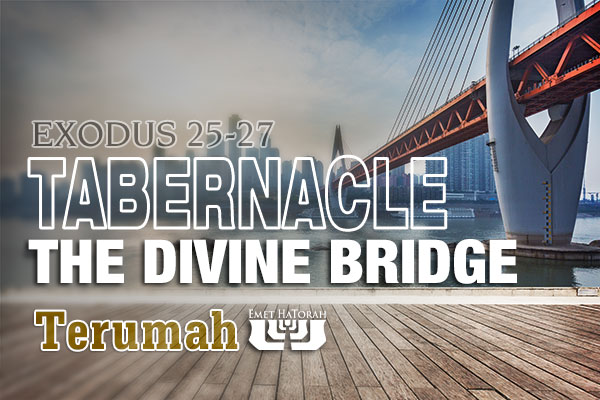Parashat Terumah - Exodus 25:1-27:19
Series:

The Bridge
Up until Parashat Terumah we hear nothing mentioned about a plan to build a Mishkan, a Tabernacle. God had delivered the Children of Israel from Egypt, taken them to be his Am Segulah (Treasured People), and given them His Torah. It seemed like a finished product, with the exception of taking them to their land. Now, however, Moses comes back down Mt. Sinai and begins communicating the plans Hashem has given him to build a portable structure that they would set up and tear down at each of their encampments. The Mishkan would become a holy edifice that will allow interaction between God and man. It would be something like a portal by which the priesthood will be able to enter the presence of the Almighty, similar to what only Moses was allowed to do thus far. But in order to accomplish this momentous task, the Children of Israel would have to work together for this common cause. The Torah records for us Hashem’s request:
The LORD said to Moses, “Speak to the people of Israel, that they take for me a contribution. From every man whose heart moves him you shall receive the contribution for me.” (Exodus 25:1–2)
What was the goal? Was it so that God could dwell in a structure? Was it so that they could rival pagan religious practices? No. He gives Moses the reason. He said, “And let them make me a sanctuary, that I may dwell in their midst” (Exodus 25:8). It was for this singular reason that Hashem desired the Tabernacle to be built. He wanted to create a bridge between God and man, an edifice that could cross over both time and space to bring man into union with his Creator. But in order for this structure to fulfill its purpose, it couldn’t just be a structure. It had to be built in such a way that it was a miniature copy of the Divine Tabernacle that already existed in the heavenly realm. Hashem told Moses:
Exactly as I show you concerning the pattern of the tabernacle, and of all its furniture, so you shall make it. (Exodus 25:9)
The author of the book of Hebrews emphasizes this point by saying that the Tabernacle was created to “serve as a copy and shadow of the heavenly things” (Hebrews 8:5). It was to be the closest thing on earth to the dwelling place of God in Heaven. Its sanctity (holiness) was unparalleled.
But this sanctity could not exist without boundaries. Holiness can only exist within boundaries because holiness is defined in terms of boundaries. The Tabernacle proper (and all of its furnishings as well) was strictly off limits to the common Israelite. Only the Levites were allowed access to this holy house, and even they were limited in their access. There were portions of it that were only accessible by the Kohanim, the priesthood. But if the idea of the Tabernacle was to be a bridge between God and man, then why was access to it restricted to a select group of people? Shouldn’t it have been freely accessible to everyone?
In a marriage, intimacy is not achieved through allowing others equal access to our spouses. Intimacy is only achieved through establishing the proper boundaries in order to protect the relationship between a man and his wife. In a healthy marriage, no one else should occupy the space in our hearts reserved only for our spouse. This is a protection against infidelity. Why does the Ark of the Covenant alone rest at the heart of the Tabernacle? Because it contained the covenant—the boundaries—that allowed for God’s intimacy with man. True intimacy only exists within boundaries.
The world wants us to believe that boundaries are barriers to intimacy. And unfortunately, a large majority of the church has fallen for this line of reasoning as well. However, rather than being barriers, those boundaries are what undergird holiness and intimacy. The Tabernacle established boundaries for the Children of Israel, but only for the purpose of becoming a bridge by which they could encounter the God of the Universe. The Torah establishes boundaries between common man and a holy God. We can view it as either a barrier or a bridge. Which one do you see it as?








